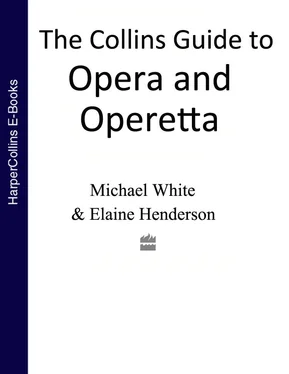Setting:A fortress near Seville; 18th century
ACT IFlorestan, a political prisoner and freedom fighter, has been flung into a dungeon by Pizarro and is slowly starving to death, while Pizarro spreads rumours that he has already died. Leonore, suspecting the truth, has disguised herself as a man, Fidelio, and has been taken on as an assistant by Rocco, swiftly becoming a trusted aide. Marzelline, Rocco’s daughter, is unaware of the disguise and has taken a considerable fancy to Fidelio, rejecting the overtures of Jaquino, her jealous former suitor. Leonore learns that Don Fernando, the king’s minister, is coming to inspect the prison, having heard that Pizarro is unlawfully locking up his own personal enemies. To Leonore’s horror, Pizarro gives Rocco money and instructs him to kill Florestan. Rocco declines to commit murder, but agrees to dig a grave in the prison dungeon if Pizarro will do the deed himself. Meanwhile Leonore has urged Rocco to allow the prisoners out for some light and air, but she is heartbroken to find Florestan is not among them. Rocco then tells her that she is to help with the gravedigging so at least she will be able to see Florestan and perhaps be able to help him; if nothing else she will die with him.
ACT IIRocco and Leonore enter the dungeon where Leonore is shocked to see her emaciated and chained husband, although she is careful to control her behaviour to avoid rousing Rocco’s suspicions. Leonore persuades Rocco to allow her to offer the condemned prisoner some bread and wine. Suddenly Pizarro bursts in, dagger in hand, and rushes towards Florestan – only to be stopped by Leonore who throws herself between them, declaring that she will shoot Pizarro, with a pistol she has kept hidden, before he kills Florestan. At this moment a fanfare is heard and Jaquino announces the minister’s arrival. Florestan is saved and, in a symbolic gesture, he is released from his chains by Leonore. The minister orders the immediate release of all the prisoners and the arrest of Pizarro. Justice is done.
Music and Background
Fidelio is a mixture of music and speech which can prove upliftingly sublime or stodgily leaden, depending on how it’s done and (critically) how much of the speech is left in. Beethoven had no previous experience of writing opera, and he took enormous trouble over it, passing through three different versions, a different name ( Leonore ) and four overtures before arriving at a final form. You could argue that the effort shows. There is also an uncomfortable relationship between the domestic and heroic elements in the opera, and a sense in which the great but static chorus of celebration at the end takes the whole thing out of the realms of theatre and into oratorio. But there is no denying the sincere depth of emotion involved, or the fact that Fidelio can be an exhilarating and radiantly affirmative experience – in the right hands.
Highlights
The canonic quartet ‘Mir ist so wunderbar’, Leonore’s aria ‘Komm, Hoffnung’, and the prisoners’ chorus ‘O welche Lust’ in Act I; the Leonore/Florestan duet ‘O namenlose Freude!’ and final chorus ‘Wer ein holdes Weib errungen’ in Act II.
Did You Know?
 Fidelio ’s subtitle is Die Eheliche Liebe ( Married Love ), and Leonore is very much the idealised woman Beethoven spent his life searching for but never finding. She also represents a comparatively rare example in opera of the female lead as active heroine rather than passive victim.
Fidelio ’s subtitle is Die Eheliche Liebe ( Married Love ), and Leonore is very much the idealised woman Beethoven spent his life searching for but never finding. She also represents a comparatively rare example in opera of the female lead as active heroine rather than passive victim.
 Fidelio is said to have been based on a true incident in the French Revolution.
Fidelio is said to have been based on a true incident in the French Revolution.
Recommended Recording
Christa Ludwig, Jon Vickers, Philharmonia Orchestra/Otto Klemperer. EMI CMS7 69324-2. A classic 1962 recording with a warmth and dynamism that remain unmatched.
Vincenzo Bellini
(1801–35)
I Capuleti e I Montecchi (1830)
La Sonnambula (1831)
Norma (1831)
Beatrice di Tenda (1833)
I Puritani (1835)
If Rossini was the presiding genius of Italian bel canto opera in the first half of the 19th century, Donizetti and Bellini were his two lieutenants, and like Rossini, they made their mark in Naples before moving on to Paris, which was the centre of the operatic world. Bellini was Sicilian by birth and showed an early gift for melody that got him noticed while he was still a student. His first full-length opera was staged at Naples’ Teatro San Carlo when he was twenty-three and a commission from Milan followed immediately, spreading his fame beyond Italy. From then on came a steady flow of work, totalling ten operas in ten years – frantic productivity by modern standards but fairly modest by the standards of the time. In fact, Bellini took uncommon care over his work, suiting the music to specific voices (from which he nonetheless made great demands) and developing a close association with the poet Felice Romani, which became one of the most effective composer/librettist partnerships in opera history.
Norma

FORM: Opera in two acts; in Italian
COMPOSER: Vincenzo Bellini (1801–35)
LIBRETTO: Felice Romani; after Alexandre Soumet’s verse tragedy
FIRST PERFORMANCE: Milan, 26 December 1831

Principal Characters
Oroveso,chief of the druids and Norma’s father  Bass
Bass
Pollione,Roman pro-consul in Gaul  Tenor
Tenor
Norma,high priestess of the druid temple  Soprano
Soprano
Adalgisa,young priestess of the temple  Soprano
Soprano
Clotilde,Norma’s confidante  Mezzo-soprano
Mezzo-soprano
Flavio, Pollione’s friend  Tenor
Tenor
Synopsis of the Plot
Setting:Gaul; the Roman occupation
ACT IOroveso comes to the sacred grove to pray to the gods to help him raise support to fight and defeat the Romans. After he has left, Pollione confides to Flavio that he no longer loves Norma, who has broken her vows of chastity for him and secretly borne his two children; he has transferred his affections to the young priestess, Adalgisa. When Adalgisa joins him, Pollione successfully persuades her to renounce her vows and go back to Rome with him. Adalgisa, in some distress, goes to see Norma to ask to be released from her vows. Norma, sympathising with her predicament, agrees to do so and asks the name of her lover. At that moment Pollione himself enters and Norma, stunned, realises the truth. She furiously denounces Pollione and the shocked Adalgisa declares that her first loyalty is to Norma, rejecting Pollione’s desperate attempts to persuade her to go with him.
Читать дальше

 Fidelio ’s subtitle is Die Eheliche Liebe ( Married Love ), and Leonore is very much the idealised woman Beethoven spent his life searching for but never finding. She also represents a comparatively rare example in opera of the female lead as active heroine rather than passive victim.
Fidelio ’s subtitle is Die Eheliche Liebe ( Married Love ), and Leonore is very much the idealised woman Beethoven spent his life searching for but never finding. She also represents a comparatively rare example in opera of the female lead as active heroine rather than passive victim.
 Bass
Bass










